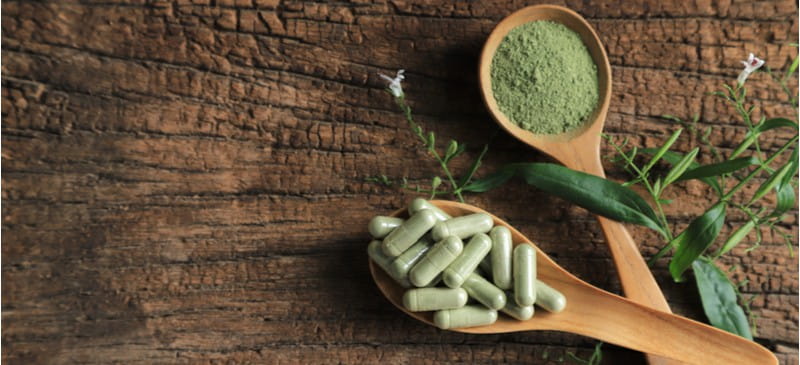The Rise of Andrographis: History and Benefits
Have you heard of andrographis? This remarkable plant has been used for centuries in Asia as a traditional medicine for a range of ailments.
It’s also an important constituent of at least 26 Ayurvedic formulas, and today it’s touted as a top antiviral herb and remedy for respiratory conditions.
This cold-property herb helps:
- reduce fever
- combat inflammation
- reduce oxidative stress
- relieve symptoms of the common cold and flu
It’s a multifaceted plant that can be added to your natural remedy medicine cabinet.

What Is Andrographis?
Andrographis is a bitter-tasting, therapeutic plant that’s native to South Asian countries like India and Sri Lanka. The leaves and underground stem of the plant are used in herbal medicine for a range of health issues, from digestive problems to infections and heart disease.
Andrographis paniculata is also known as “Indian echinacea,” and it has a long history of use in Traditional Chinese Medicine and Ayurvedic medicine.
The main compounds in the plant are called andrographolides, and they are known for their antioxidant, anti-inflammatory and antiviral effects. This allows androphraphis to be used as a natural immune-booster that fights infections and improves cold and flu symptoms.
Benefits/Uses
Research indicates that andrographis possesses several constituents with unique biological properties. Extracts and pure compounds of the plant have been shown to possess antimicrobial, antioxidant, anti-inflammatory, anti-diabetic and immunostimulant functions.
Here’s a breakdown of the plant’s specific health benefits and uses:
1. Fights the Common Cold
Andrographis is used to shorten the duration of cold symptoms, including sore throat and cough. Traditionally, the plant has been used in Indian and Chinese herbal medicine for colds, influenza and cough.
Studies indicate that the plant’s extracts appear to be beneficial and safe for relieving respiratory symptoms and shortening time to symptom resolution.
Research on using andrographis alone also has shown positive results for upper respiratory infections.
2. Lowers Fever
Andrographis is known as a cold-property herb that’s used to rid the body of heat and fever. Research has revealed that it’s also used to dispel toxins from the body.
The plan works to combat infections, fight inflammation and boost immunity as well.
3. Reduces Inflammation
Research suggests that andrographolide, the main compound in the plant, can significantly reduce inflammation that’s caused by histamine, adrenaline and dimethyl benzene.
Because of its anti-inflammatory effects, andrographis has been used to relieve health conditions including ulcerative colitis and rheumatoid arthritis.
4. Fights Infections and Boosts Immunity
Traditionally, andrographis has been used to relieve symptoms of respiratory infections and boost immunity. It possesses antimicrobial and antiviral properties that have been proven to fight infections.
The plant’s compounds have displayed antibacterial activity against Salmonella, Shigella, E. coli and Staphylococcus aureus. Research also concludes that andrographolide has antiviral properties and is able to restrain virus replication and virus-induced pathogenesis.
5. Works as an Antioxidant
Studies show that andrographis contains antioxidants that protect components of the human body from oxidative damage. A. paniculata has been found to significantly increase the activity of antioxidant defense enzymes.
It has also exhibited free radical-scavenging ability.
6. May Have Anticancer Effects
There’s some research suggesting that andrographis has anticancer effects. It has exhibited potent cytotoxic activity against cancer cells, and the main compound in the plant, andrographolide, is believed to have strong anticancer activity that induces cell changes.
7. Has Anti-diabetic Effects
Animal studies have found that andrographis extract has anti-diabetic potential, and research published in Frontiers in Pharmacology indicates that andrographolide has a potential role in the management of metabolic syndrome. Although human research is needed, the plant has been used in folk medicine for diabetes and liver dysfunctions.
Beyond these proven benefits, there are studies suggesting that compounds in andrographis may help improve the following health issues:
- Diarrhea
- Cardiovascular disease
- High cholesterol
- Renal disease
Dosage
In traditional medicine, the leaves, stem and root of andrographis were used to create tinctures, teas, powders, juices and pastes. These formulas were ingested or applied topically to improve a range of conditions, from intestinal worm infestation to eczema, gonorrhea and infected wounds.
Today, popular forms of andrographis include capsules, extracts, tinctures and teas. There is no single recommended dose for the plant or its compounds, but various doses have been studied.
For the common cold, one report suggests a “reasonable dose regimen” of a 300-milligram tablet, four times daily, for the first few days of symptoms.
For fever reduction and relief from inflammatory issues or pain, taking a higher dose of three to six grams daily is typically recommended.
Another common dose for ulcerative colitis and issues related to inflammation is 1,200–1,800 milligrams of andrographis extract per day for eight weeks.
To determine the right dose for your needs, speak to your naturopathic doctor or health care professional.
Risks and Side Effects
Andrographis is not recommended for children or women who are pregnant or nursing. If you have autoimmune disease, speak to your health care provider before using andrographis, as it works to stimulant the immune system and may increase symptoms.
People with bleeding disorders or low blood pressure should not use the plant or its compounds without consulting with their health care professionals. It’s also recommended to avoid using the herb if you are on medications for slowing blot clots, including aspirin, ibuprofen and warfarin.
Conclusion
- Andrographis is an herb that’s been used for thousands of years in traditional and folk medicine.
- It’s been used for a range of health conditions, including respiratory tract infections, fever, digestion, diabetes, pain, inflammatory conditions and cancer.
- There’s no recommended dose for andrographis, as the proper amount depends on your health needs. The typical doses range from 1,200 milligrams to six grams per day.
- Andrographis is available in tea, capsule, tincture and extract forms.





Leave a comment